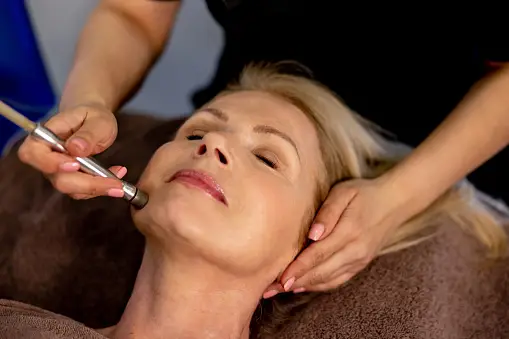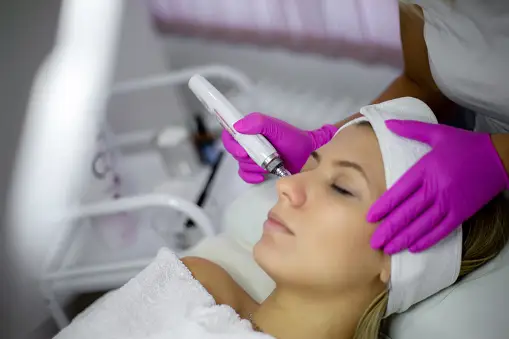Microneedling is a cosmetic procedure that involves using a device with fine needles to create tiny punctures in the skin. These punctures stimulate the skin’s natural healing response, leading to the production of collagen and elastin, which can improve the appearance of various skin concerns.
The success rate of microneedling can vary depending on several factors, including the specific skin condition being treated, the individual’s overall health, the skill of the practitioner performing the procedure, and the treatment regimen followed. It’s important to note that success rates are subjective and can vary from person to person.
Microneedling has been found to be effective in treating various skin issues, including acne scars, fine lines and wrinkles, hyperpigmentation, stretch marks, and uneven skin texture. In general, studies have shown that microneedling can yield positive results in improving these conditions.
However, it’s crucial to manage expectations as the success rate may not be 100% for everyone. Some individuals may experience significant improvement in their skin concerns, while others may see more modest results. Additionally, multiple treatment sessions are usually required for optimal outcomes, and maintenance treatments may be necessary to sustain the benefits.
To determine the best approach for your specific skin concerns and to assess the expected success rate, it is advisable to consult with a qualified dermatologist or aesthetician who can evaluate your skin condition and provide personalized recommendations. They can help you understand the potential benefits and limitations of microneedling based on your individual circumstances.

What is the downside of microneedling?
While microneedling is generally considered a safe and effective procedure, there are some potential downsides and risks associated with it. These include:
- Skin irritation and redness: After microneedling, it is common to experience temporary skin redness, swelling, and mild irritation. These side effects usually subside within a few hours to a few days, depending on the intensity of the treatment. However, in some cases, they can persist for longer periods.
- Pain and discomfort: Microneedling involves puncturing the skin with fine needles, which can cause varying levels of discomfort. The sensation during the procedure may range from mild pricking to a more intense stinging or scratching feeling, depending on the individual’s pain tolerance and the depth of the needles used. Topical numbing creams are often applied before the procedure to minimize discomfort.
- Skin infection and scarring: If proper hygiene practices are not followed or if the procedure is performed in an unsterile environment, there is a risk of developing a skin infection. Additionally, if the microneedling device is not used correctly or if the skin is not adequately prepared, there is a small possibility of scarring or the formation of post-inflammatory hyperpigmentation (darkening of the skin).
- Unsatisfactory results: While microneedling can yield positive results for many individuals, it’s important to note that the degree of improvement can vary. Some people may see significant improvement in their skin concerns, while others may experience more modest results. The success of the treatment can depend on factors such as the severity of the skin condition being treated, the individual’s skin type, and their body’s response to the treatment.
- Sun sensitivity: After microneedling, the skin may become more sensitive to the sun. It is important to protect the treated area by using sunscreen and avoiding excessive sun exposure for a few days after the procedure to reduce the risk of sunburn or hyperpigmentation.
- Cost and time commitment: Microneedling is not a one-time treatment. It usually requires multiple sessions spaced several weeks apart to achieve optimal results. This can make the overall cost of the procedure add up, and the time commitment may not be suitable for everyone.
It’s important to discuss these potential downsides and risks with a qualified professional before deciding to undergo microneedling. They can provide personalized advice and guidance based on your specific skin concerns and medical history.
Why don’t you see results from microneedling?
There could be several reasons why an individual may not see the desired results from microneedling. These include:
- Insufficient number of treatments: Microneedling typically requires multiple treatment sessions to achieve noticeable improvements in the skin. The number of sessions needed depends on various factors, including the skin concern being addressed, its severity, and the individual’s response to the treatment. If an individual undergoes too few sessions, they may not see the desired results.
- Inadequate needle depth or intensity: The depth at which the needles penetrate the skin during microneedling can impact the effectiveness of the treatment. If the needles are not set to an appropriate depth or if the intensity of the treatment is insufficient, it may not stimulate the skin enough to promote the desired collagen and elastin production. A skilled practitioner should determine the appropriate settings based on the individual’s skin condition.
- Inappropriate treatment for the specific concern: Microneedling is effective for a range of skin concerns, but it may not be the most suitable treatment for certain conditions. For example, deep pitted acne scars or certain types of hyperpigmentation may require other treatment modalities, such as laser therapy or chemical peels, to achieve better results. It’s important to consult with a dermatologist or aesthetician who can assess your specific skin concern and recommend the most appropriate treatment.
- Underlying health or lifestyle factors: The effectiveness of microneedling can also be influenced by underlying health conditions or lifestyle factors. Factors such as smoking, excessive sun exposure, poor nutrition, or inadequate skincare routines can impact the skin’s ability to heal and respond to the treatment. Addressing these factors and adopting a healthy lifestyle can enhance the results of microneedling.
- Individual variation in response: Every individual’s skin is unique, and responses to microneedling can vary. Some individuals may be more responsive to the treatment and experience significant improvements, while others may have a more limited response. Genetic factors, skin type, and overall skin health can influence the outcome of microneedling.
If you are not seeing the desired results from microneedling, it’s important to consult with the professional who performed the treatment or seek the advice of a dermatologist. They can evaluate your specific situation, assess the treatment approach, and provide recommendations tailored to your needs.
What do dermatologists say about microneedling?
Dermatologists generally regard microneedling as an effective and safe cosmetic procedure for improving skin texture, reducing scars, and promoting collagen production. Here’s a breakdown of what dermatologists commonly say about microneedling:
- Stimulates Collagen Production: The micro-injuries created by the needles trigger the skin’s natural wound healing process, which boosts collagen and elastin production. This helps improve skin texture, firmness, and elasticity.
- Effective for Scars and Fine Lines: Dermatologists often recommend microneedling to reduce acne scars, surgical scars, and stretch marks. It’s also used to minimize fine lines and wrinkles by encouraging skin regeneration.
- Improves Skin Tone: Microneedling can help improve the appearance of hyperpigmentation, sun damage, and melasma by promoting cell turnover and new skin growth.
- Safe for Most Skin Types: Unlike some laser treatments, microneedling is generally safe for all skin tones because it doesn’t use heat, which can increase the risk of hyperpigmentation in darker skin tones.
- Minimal Downtime: The procedure typically has minimal downtime, with most people experiencing redness for a day or two before returning to their normal activities. This makes it a popular option for those seeking less invasive treatments.
- Can Be Combined with Other Treatments: Dermatologists often combine microneedling with other procedures like PRP (platelet-rich plasma), serums, or topical medications to enhance results and deliver nutrients deep into the skin.
- Multiple Sessions for Best Results: While some improvement can be seen after one session, dermatologists usually recommend multiple sessions spaced several weeks apart for optimal results, especially for treating deeper scars or wrinkles.
- Potential Risks: Though considered safe when performed by a professional, microneedling can carry risks such as infection, irritation, or prolonged redness, especially if not done properly or if aftercare guidelines aren’t followed.
Consulting a dermatologist before undergoing microneedling is highly recommended to ensure it’s appropriate for your skin concerns and to avoid complications.
